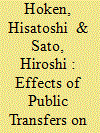| Srl | Item |
| 1 |
ID:
186215


|
|
|
|
|
| Summary/Abstract |
Using the last three waves of the rural household surveys conducted by the Chinese Household Income Project in 2007, 2013, and 2018, this paper focuses on changes in poverty in rural China. The paper decomposes poverty change into the growth effect and the inequality effect, and also decomposes the contributions of income components, concentrating particularly on income from public transfers. Economic growth had a very significant poverty reduction effect for both absolute and relative poverty, but the inequality effect mostly offset it; in total, absolute poverty reduced significantly, and relative poverty increased from 2007 to 2018. Local wage income became the main contributor to both absolute and relative poverty reduction, replacing household agricultural operational income, and the contribution of wage income from migration declined. Public transfers effectively reduced absolute poverty but not relative poverty.
|
|
|
|
|
|
|
|
|
|
|
|
|
|
|
|
| 2 |
ID:
188153


|
|
|
|
|
| Summary/Abstract |
This study examines the impacts of public transfers on income inequality and poverty reduction in rural China. It uses nationally representative rural household surveys from the China Household Income Project and classifies public transfers into three types – universal, pro-poor, and reimbursable transfers – to compare the impacts of each type of public transfer in 2013 and 2018. Estimated results show that the contributions of each type of public transfer to reducing income inequality were generally small in both 2013 and 2018. However, the effects of reimbursable transfers were the largest of the three types. We also found that the poverty-reducing effects were the largest for reimbursable transfers, and their impacts have considerably improved in the western region. The impacts of pro-poor transfers were intermediate but have developed notably in the central region. These findings suggest that reimbursable and pro-poor transfers contributed mainly to reducing rural poverty but the impacts were heterogeneous among regions.
|
|
|
|
|
|
|
|
|
|
|
|
|
|
|
|